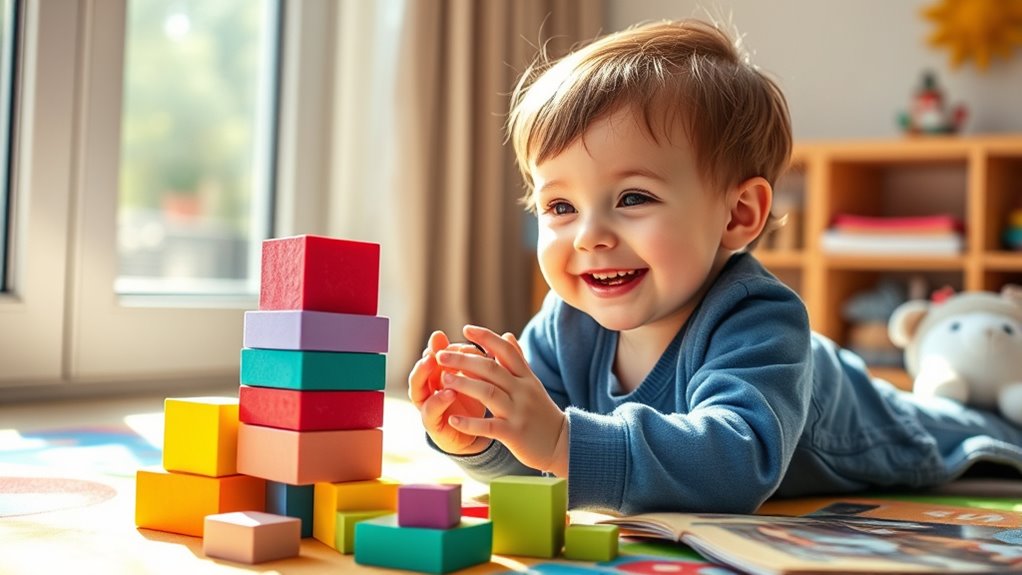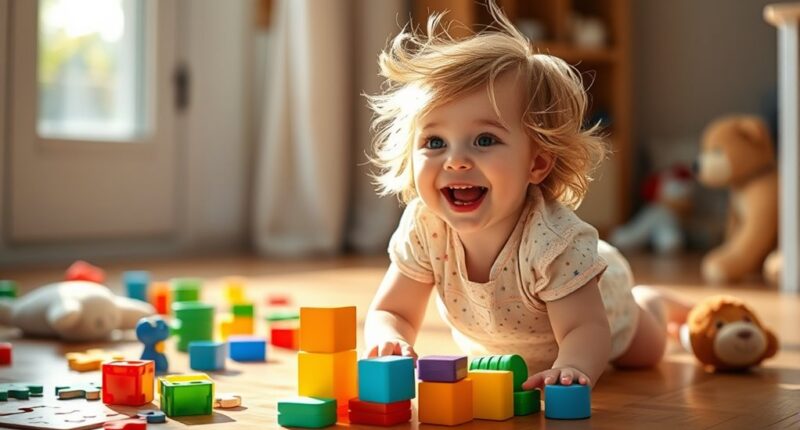To turn learning into a game for your playful toddler, incorporate daily activities that promote movement and exploration. Use simple obstacle courses, chase games, or creative challenges with everyday objects to encourage physical skills, confidence, and emotional resilience. Celebrate small victories and support your child through setbacks, making every experience fun and rewarding. If you keep exploring, you’ll discover even more ways to make every moment a powerful opportunity for growth and joy.
Key Takeaways
- Incorporate everyday objects into fun activities to promote exploration and learning.
- Use simple obstacle courses and playful challenges to develop motor skills and confidence.
- Turn routine tasks into games to make learning engaging and enjoyable for toddlers.
- Celebrate small achievements to boost emotional resilience and a positive attitude toward learning.
- Combine physical play with emotional support to foster holistic growth and a love for discovery.

Have you ever watched a toddler turn everyday objects into toys or giggle at their own silly antics? It’s a delightful reminder of how naturally curious and inventive young children are. During these moments, you might notice how they’re not just playing—they’re developing essential skills that lay the foundation for their future growth. When your toddler stomps around or reaches for that bright red ball, they’re working on their gross motor skills, which involve the large muscles needed for walking, running, jumping, and balancing. These activities aren’t just about physical strength; they also boost their confidence and independence. Every step they take, every climb up a couch, helps them master coordination and control, turning play into a *crucial* part of their development.
Playing with everyday objects helps toddlers develop gross motor skills and boosts confidence.
But play isn’t only about movement. It’s equally *vital* for emotional development. As your toddler explores and engages with their environment, they learn to manage feelings like excitement, frustration, or disappointment. When they fall during a game or struggle to reach a toy, they’re experiencing small setbacks that teach resilience and patience. By cheering themselves on or calming down after a minor mishap, they build emotional resilience and a sense of achievement. You might notice how they giggle after tumbling or cheer when they succeed in stacking blocks—it’s their way of processing emotions and gaining confidence. These moments of playful exploration help them understand their feelings and develop a positive self-image.
Encouraging your toddler to turn everyday activities into playful adventures enhances both their physical and emotional development. For instance, you can set up simple obstacle courses with cushions and toys, prompting them to crawl, climb, and balance. This not only strengthens their gross motor skills but also offers opportunities to celebrate small victories, fostering emotional resilience. When you cheer them on or join in the fun, you reinforce their sense of safety and support. Additionally, incorporating hydration techniques during playtime can help keep their energy levels high and support overall health. The more you engage in play that challenges their physical abilities and emotional responses, the more they learn about their own strengths and limits. This kind of play is *crucial* because it makes learning feel natural and enjoyable, rather than a chore.
In the end, playful activities are the best way to nurture your toddler’s holistic growth. They develop gross motor skills through movement, while their emotional development blossoms through the ups and downs of playful experiences. By turning everyday objects and routines into playful opportunities, you’re helping your child grow into a confident, emotionally resilient little person—ready to face new adventures with a smile.
Frequently Asked Questions
How Can Parents Balance Play and Structure Effectively?
Balancing play and structure is essential for your child’s development. You can do this by incorporating parental involvement in daily routines and creating a dedicated playroom setup that encourages both learning and fun. Set clear boundaries and schedule specific times for structured activities, then allow free play to foster independence. This approach guarantees your child benefits from guided learning while enjoying the natural joy of play.
What Are Signs of Developmental Readiness for Different Games?
You can tell your child is ready for different games when their motor skills improve and they start showing interest in new activities. Look for signs like improved coordination, the ability to follow simple instructions, and reaching language milestones such as using words or phrases. If they enthusiastically participate, mimic actions, or express excitement, it indicates they’re developmentally prepared to enjoy and benefit from age-appropriate games.
How Do Cultural Differences Influence Playful Learning Strategies?
Imagine a world where every child’s laughter echoes different melodies, shaped by cultural norms and play preferences. You see that cultural differences influence playful learning strategies by guiding what activities resonate most deeply. You adapt your approach to honor these diverse expressions, recognizing that play isn’t one-size-fits-all. By embracing these differences, you create a richer, more inclusive environment where every child’s unique way of learning shines brightly through playful exploration.
What Safety Precautions Should Be Taken During Active Play?
When engaging in active play, you should prioritize safety by ensuring the use of safe equipment that’s age-appropriate and in good condition. Supervision tips are essential—watch your child closely and stay nearby to prevent accidents. Clear the play area of hazards like sharp objects or furniture, and teach your child safe play behaviors. These precautions help create a fun, secure environment, reducing the risk of injuries during active play.
How to Encourage Shy or Hesitant Toddlers to Join In?
Ever wonder how to help shy toddlers join in? You can gently encourage them by using music therapy and sensory activities, creating a safe, inviting space. Wouldn’t a calming rhythm or soft textures make them feel more comfortable? By observing their cues and offering simple, engaging options, you boost their confidence. Remember, patience and gentle encouragement turn hesitant moments into joyful participation, helping shy toddlers blossom in their own time.
Conclusion
By turning learning into a game, you tap into your toddler’s natural curiosity and love for play. Studies show that children who engage in playful learning score 20% higher on cognitive tests by age five. So, next time you see your little one giggling over a puzzle or giggling during a story, remember—you’re not just having fun, you’re laying the foundation for lifelong learning. Keep it playful, and watch them thrive!









